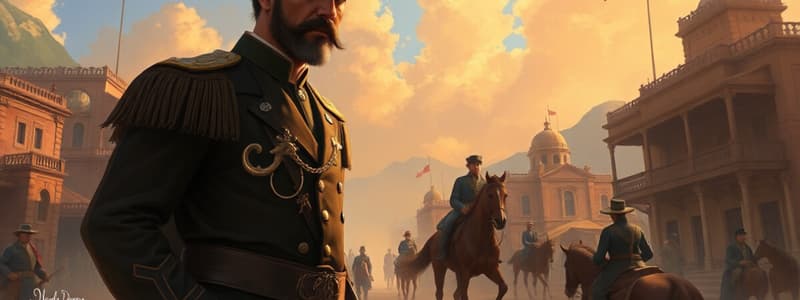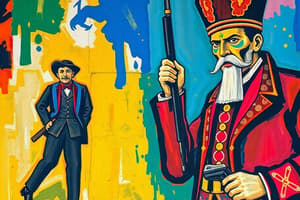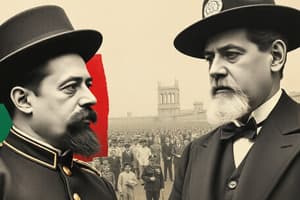Podcast
Questions and Answers
What did Madero argue should be the focus of Mexican presidents during their term?
What did Madero argue should be the focus of Mexican presidents during their term?
- Improving social benefits
- Securing a second term
- Maintaining control of the government
- Focusing on the next generation (correct)
What was the core principle of Madero's political reform?
What was the core principle of Madero's political reform?
- Promoting free and honest elections (correct)
- Implementing a strictly enforced social welfare system
- Establishing a powerful, centralized government
- Prioritizing economic development over social change
What was Madero's response to the question about breaking up his own haciendas?
What was Madero's response to the question about breaking up his own haciendas?
- He claimed that he was already taking steps to distribute his land to the people.
- He refused to answer the question, citing the need for political stability first.
- He argued that land distribution was essential for economic progress.
- He stated that his primary goal was to promote political freedom, not economic redistribution. (correct)
What does the text state about the impact of modernization on Mexico at the beginning of the 20th century?
What does the text state about the impact of modernization on Mexico at the beginning of the 20th century?
What was the reaction of the Diaz administration to Madero's anti-reelectionist movement?
What was the reaction of the Diaz administration to Madero's anti-reelectionist movement?
What was designated for all towns in the republic on the 20th day of November?
What was designated for all towns in the republic on the 20th day of November?
What primarily motivated the leaders to prepare for the revolution starting November 20?
What primarily motivated the leaders to prepare for the revolution starting November 20?
What did Aquiles Serdan possess that contributed to the premature start of the revolution?
What did Aquiles Serdan possess that contributed to the premature start of the revolution?
What diverse motivations did individuals have for joining the revolutionary cause?
What diverse motivations did individuals have for joining the revolutionary cause?
Which term describes the groups of rebels that formed during the revolution?
Which term describes the groups of rebels that formed during the revolution?
What prompted Francisco Madero to draft the Plan de San Luis Potosi?
What prompted Francisco Madero to draft the Plan de San Luis Potosi?
On what date did Madero date the Plan de San Luis Potosi?
On what date did Madero date the Plan de San Luis Potosi?
Which statement best describes the political status of Mexico on election day, June 21, 1910?
Which statement best describes the political status of Mexico on election day, June 21, 1910?
What did Madero manage to do shortly after his release from prison?
What did Madero manage to do shortly after his release from prison?
How did the general populace perceive Mexico in September 1910?
How did the general populace perceive Mexico in September 1910?
Flashcards
Madero's Anti-Reelection Stance
Madero's Anti-Reelection Stance
Madero, a prominent figure in Mexican politics, advocated against the re-election of presidents. He argued that a single term would allow presidents to focus on long-term goals for the nation.
Madero's Emphasis on Democracy
Madero's Emphasis on Democracy
Madero believed that free and fair elections were crucial for a functioning democracy. He saw this as the foundation for social progress and positive change in Mexico.
Madero's Successful Campaign
Madero's Successful Campaign
Madero's campaign message resonated across Mexico, earning him victory in 20 out of 27 states. This demonstrated a strong public desire for change and a rejection of the incumbent president.
Madero's Political Philosophy
Madero's Political Philosophy
Signup and view all the flashcards
Madero's Response to the Land Question
Madero's Response to the Land Question
Signup and view all the flashcards
Who was the dictator of Mexico during the early 1900s?
Who was the dictator of Mexico during the early 1900s?
Signup and view all the flashcards
Who was the revolutionary leader who challenged Diaz's regime?
Who was the revolutionary leader who challenged Diaz's regime?
Signup and view all the flashcards
What was the revolutionary plan that called for the overthrow of Diaz's regime?
What was the revolutionary plan that called for the overthrow of Diaz's regime?
Signup and view all the flashcards
What was the major event that led to the fall of Diaz's rule?
What was the major event that led to the fall of Diaz's rule?
Signup and view all the flashcards
What were some of the causes of the Mexican Revolution?
What were some of the causes of the Mexican Revolution?
Signup and view all the flashcards
Plan de San Luis Potosí
Plan de San Luis Potosí
Signup and view all the flashcards
What fueled the Mexican Revolution?
What fueled the Mexican Revolution?
Signup and view all the flashcards
Who started the Mexican Revolution?
Who started the Mexican Revolution?
Signup and view all the flashcards
What was the revolutionary army like?
What was the revolutionary army like?
Signup and view all the flashcards
Democracy
Democracy
Signup and view all the flashcards
Study Notes
Chapter 24: Madero and the Liberal Indictment of the Porfiriato
- Liberal Leadership: The early 20th century in Mexico was markedly different from 25 years earlier, despite industrial and economic growth. Modernization created discontent and overshadowed Porfiriato's achievements. Wealth was concentrated in the hands of a few, economic surplus was not broadly distributed, and the masses were sidelined.
- Political and Economic Grievances: The 1857 Constitution's guarantees were consistently violated. Elections were fraudulent. Press freedoms did not exist. The clergy's role was limited. The local jefe político wielded capricious power over justice. Porfirio Díaz became synonymous with both longevity and brutal rule. Intellectuals questioned the dictatorship.
- Early Reform Advocates: Orozco, a jurist from Guadalajara, criticized Díaz's land laws. He argued for breaking up large estates and promoting agricultural progress. He advocated for the government to take action from within, to effect needed reforms.
- The Flores Magón Brothers: Jesús, Ricardo, and Enrique Flores Magón published the weekly "Regeneración" in Mexico City. Their critique of corruption and injustice invigorated the liberal movement through their imprisonment and exile. Camilo Arriaga joined their movement. They later moved to the US from exile to protest the Díaz regime.
- Madero's Involvement: Francisco I. Madero, a wealthy landowner, became a significant figure in the opposition to the Díaz regime. He was instrumental in revitalizing "Regeneración" which published from the US, and his participation in the anti-reelectionist movement was pivotal in the lead-up to the revolution.
- The Liberal Plan: Published in 1906 by the St. Louis junta, it advocated for freedom of speech and press, elimination of jefes políticos, secular education, and nationalization of church property. It also called for a national eight-hour workday and elimination of child labor. It represented a more radical departure from previous liberal movements.
Chapter 26, The Revolution of 1910
- The Cananea Strike: In 1906, workers at the Cananea Consolidated Copper Company in Sonora went on strike. They were concerned about pay disparity with US workers and other issues, which erupted in violence involving US volunteers and the Mexican authorities, demonstrating the tensions.
- Labor Unrest: The Cananea strike exposed wider societal discontent. Textile workers, too, were organizing, leading to strikes in the Rio Blanco textile mills near Orizaba in 1907. This strike involved violence, death and legal challenges, and highlighted the inequalities and growing tensions.
- Heightened Political Activity: Diaz's unexpected announcement that he would not seek re-election in 1910 sparked unprecedented political activity. Intellectuals like Molina Enríquez and writers like Madero fueled the opposition.
- Madero and Anti-reelectionist Movement: Madero became a key figure in the growing opposition movement. His book "The Presidential Succession of 1910" emphasized the need for constitutional reform and democracy.
- The Plan de San Luis Potosí: Madero articulated the anti-reelection movement. This plan called for the overthrow of Díaz and initiated the revolution.
- The Rise of Rebel Armies: Local uprisings began. Discontented people, including campesinos, workers, soldiers, and others, took up arms in various regions, motivated by local grievances and broader opposition to Díaz
- The Battle of Ciudad Juárez played an important role in the revolution, leading to Díaz's resignation and exile.
Studying That Suits You
Use AI to generate personalized quizzes and flashcards to suit your learning preferences.




